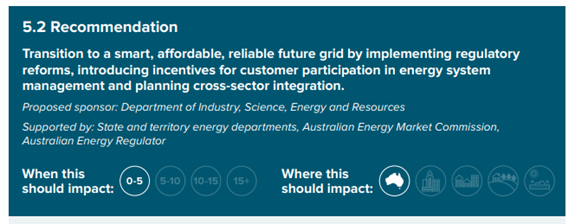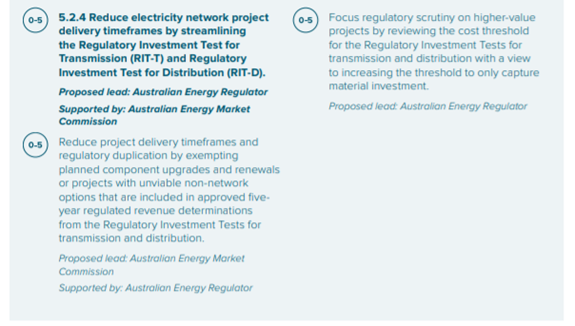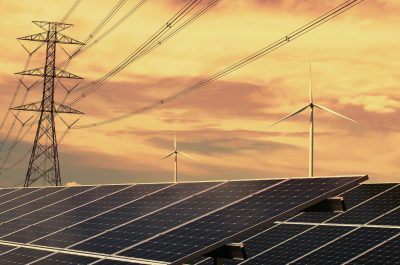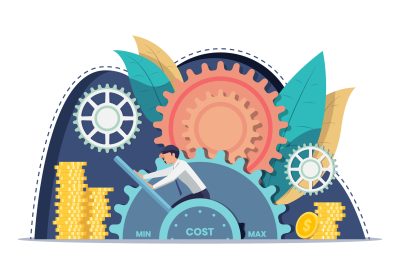Infrastructure Australia shines light on future energy needs
Like most bodies of work published anywhere in the world at the moment, the 2021 Australian Infrastructure Plan is written through the lens of an ever-unfolding pandemic, the ongoing and far reaching environmental and economic effects of climate change and the global shift towards a renewable energy sector.
Add in thirty years of unprecedented economic growth, civil stability, and an enviable standard of living with record low interest rates and you’ve got yourself an interesting time to be looking at the future of Infrastructure in Australia. So, what’s the plan for energy infrastructure in Australia? We take a look.
Putting customers first
Fig 1: 2021 Australian Infrastructure Plan, Pg 84
The transition towards a smart, affordable, reliable grid has already begun and will be accelerated over the next five to 10 years.
By government agencies and market bodies working together across jurisdictions, a fully integrated energy system that is secure and reliable is well within our grasp.
The report highlights a need for the acceleration of smart meter installation and to empower customers to participate more actively in their energy usage.
It recommends mandating time-of-use tariffs to encourage more efficient energy consumption patterns from customers.
The report also acknowledges how the incredible uptake of solar in homes has led to grid instability and potential unreliability in some areas. The implementation of time-of-use tariffs is promoted as a means to create more stability on the grid and encourage consumers to utilise their excess solar at times of peak generation and low demand.
Electric vehicles enter the fray to help networks smooth out the peaks and troughs of energy usage in Australians homes. Properly managed, EV charging will help soak up excess renewable generation and stored energy in batteries could support peak demand when the sun goes down.
Electric vehicle integration into the grid and on our highways is real and it’s happening now. With the cost of fuel skyrocketing and the batteries in electric vehicles lasting longer, the internal combustion engine is going the way of the horse and cart.
Infrastructure Australia is calling for a national cross-sector plan to integrate electric vehicles with the grid and encourage charging infrastructure to be implemented nationally.
By undertaking a national integration strategy, system operators will be able to integrate zero-emissions vehicles into the grid safely and cost-effectively.
Transmission: the pathway to transition
As Australia moves towards a decarbonsied energy future, more and more renewables are coming online and entering our energy grid.
An essential part of the transition is new transmission. A crucial question – and one being considered as part of transmission access reform work led by the Australian Energy Market Commission and supported by the Energy Security Board – is how the costs of transmission infrastructure development are to be efficiently allocated. Infrastructure Australia recommends transmission interconnector costs are allocated to the beneficiaries and supports the implementation of transmission access reform to help new generation connect to the grid more efficiently.
By implementing the Australian Energy Market Operator’s Integrated System Plan, that has already identified key energy infrastructure projects, this could reduce project timelines and see more certainty for investors and NSPs.
Fig 2: 2021 Australian Infrastructure Plan, Pg 86
Reform would enable more certainty for investors and see a streamlined process for the regulatory investment test for transmission (RIT-T) and a regulatory investment test for distribution (RIT-D). The robustness of the investment decisions could be preserved by focusing RITs on more material investment and leaving networks to still develop business cases for other specific types of investments that are able to be scrutinised through the regulatory processes. This could focus engagement better on the higher value projects.
Powering a cheaper, cleaner future through gas
Fig 3: 2021 Australian Infrastructure Plan, Pg 87
Being resources rich and politically stable has meant Australia has been an energy export supplier of choice for the rest of the world. It is important that Australia holds onto that title to secure its economic prosperity.
To achieve this, Infrastructure Australia recommends developing clear, outcome- focused legislation and regulation to enable emerging low-emissions energy technology and grow export industries and jobs in clean energy commodities.
Domestically, the report recommends getting the most out of our existing gas infrastructure and that we consider the potential transition to renewable sources such as hydrogen and biogas. Renewable gas production and use for domestic heating is already being explored by gas networks throughout the country.
By creating a nationally consistent policy that prioritises new gas sources and hydrogen, Australian homes and businesses can be provided with reliable and affordable energy.





